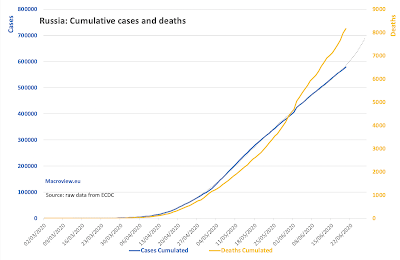As promised earlier (https://trueeconomics.blogspot.com/2020/07/3720-services-composite-pmis-q2-2020.html), here are the BRIC Services and Composite PMIs for 2Q 2020 with updated Global PMIs. Note: my charts show quarterly PMIs, derived from the Markit's monthly data.
Services sectors:
As the above shows, 2Q 2020, Services sector growth in India and Russia lagged Global sector activity.
Manufacturing:
India, Russia and Brazil manufacturing sector activity lagged Global activity in 2Q 2020. The same three BRIC economies also lagged Global Composite PMI development:
Per Markit release, here are the main developments in Global PMIs on monthly basis:
Manufacturing Index Summary:
There are robust forward expectations in all sectors of the Global PMIs, per above. Input prices are rising, but output prices continue to contract, albeit at shallower rates. Employment is still falling in both sectors. New business is still contracting, albeit at a slower rate, with exports declining sharper than domestic orders.
Overall, the numbers are still indicating ongoing contraction through June for BRICs and for the Global economy.
Looking at monthly PMIs, China and Brazil posted above 50.0 readings in June for Manufacturing, and China also posted a highly robust growth signal for Services. Brazil posted deeply contractionary June Services PMI reading, while Russia shows contraction ongoing (but at a shallower rate than in May) in both sectors. India posted continued decline in Manufacturing and a sharp continued contraction in Services. These numbers put a question mark over the prospect for a V-shaped recovery. April 2020 marks the trough of PMIs-signalled growth in the BRICs. We now have second month in a row of rising PMIs readings, but the indices are still below 50 line. On a quarterly basis, however, 1Q 2020 marks the BRICs recession in terms of PMIs signals (Composite country indices), with 2Q 2020 posting shallower rates of decline compounding 1Q 2020 drops.












